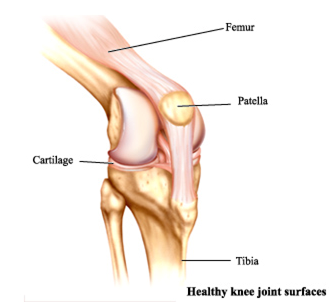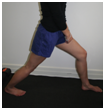The knee is one of the most commonly injured joints in the body, especially on the sports field. As it is a weightbearing joint, an injury to the knee can often severely affect your everyday activities.
Basic Anatomy of the Knee

The knee joint is made up of 3 bones: the tibia, femur and the patella (knee cap). There are 4 main ligaments in and around the knee joint that help keep the joint stable called the medial and lateral collateral ligaments (on either side of the knee) and the anterior and posterior cruciate ligaments. There is also cartilage between the bones called menisci. These act to help cushion the bones but can be quite commonly torn with a twisting injury.
Injury Management –What To Do
If you injure your knee you may notice some swelling or bruising. Here are some tips of how to manage your knee injury initially.
| P | PROTECT | It is important to protect the knee joint from further injury. This may involve using crutches for a few days to allow you to walk properly. As your pain settles and you start to improve you can progress onto 1 crutch but this should always be used on the opposite side of your injury |
| R | RELATIVE REST | from any activities that increase your pain or swelling especially weightbearing activities. |
| I | ICE | Ice should be used immediately to decrease the swelling as too much swelling will weaken the quadriceps (thigh muscles). Never apply ice directly onto the skin, wrap it in a wet tea towel and apply for 10 –15min, remove for 10-15min and reapply as needed |
| C | COMPRESSION | Use tubigrip or a bandage to help control swelling |
| E | ELEVATION | Elevate your leg whenever possible to help decrease the swelling |
Over the counter anti-inflammatories include: Nurofen or Voltarentablets. Generally these should be taken the day after the injury and need to be taken for at least 3 consecutive days to decrease inflammation. They must be taken with food to avoid stomach complications. On the night of the injury paracetamol or codeine can be used to assist with pain. If you’re not sure if you can take any of these medications then speak to your doctor or pharmacist first.
If you have Voltaren gel or fisiocremyou can also rub this over the injured area ( however don’t use voltaren gel and tablets together )
Here are some simple exercises that you can start doing once the swelling and pain have subsided. These exercises should be performed 2-3 times a day.
Here are some simple exercises that you can start doing immediately. These exercises should be performed 2-3 times a day for short periods.
CALF STRETCH:

Stretch your leg behind you keeping your heel on the ground. Hold 20 –30 seconds.
STATIC QUADRICEPS STRETCH:

While lying down on your back, actively straighten your leg, pushing the back of your knee into the bed/towel
Hold for 3 seconds and repeat up to 10- 15 times.
Gradually build up to holding for 10 seconds
KNEE FLEXION:

While lying on your back, slowly bend and straighten your knee.
If you require any further information or treatment please contact one of our physios at Leap Back Physio. We have 3 practitioners available and are now open 6 days a week.